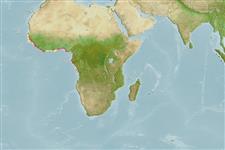>
Blenniiformes (Blennies) >
Blenniidae (Combtooth blennies) > Salariinae
Etymology: Hypleurochilus: Greek, hypo = under + Greek, pleura = in the side of + Greek, cheilos = lip.
More on author: Fowler.
Environment: milieu / climate zone / depth range / distribution range
Ecologie
marien; brak water demersaal. Tropical
Eastern Atlantic: northern Senegal to the mouth of the Congo (Ref. 4342, 81288). Also reported from Annobon Island (Ref. 5298).
Grootte / Gewicht / Leeftijd
Maturity: Lm ? range ? - ? cm
Max length : 8.3 cm TL mannelijk / geslacht onbekend; (Ref. 81288)
Dorsale stekels (totaal): 12; Dorsale zachte stralen (totaal): 14-17; Anale stekels 2; Anale zachte stralen: 16 - 19. Diagnosis: length of supraorbital tentacles varies from approximately 2/3 of eye diameter to 2 times this diameter; longest tentacles occur in male specimens; shape of supraorbital tentacles varies from a single finger-like appendage bearing 2-4 filaments at the rear base to 4 appendages of almost equal length; anterior nostril forms a small tube which bears up to 4 cirri on posterior rim, only 1 in most cases; only one ring of cephalic sensory pores in infraorbital and preopercular series; lateral line does not reach beyond level of 8th-10th spine of dorsal fin; both males and females with a thin crest on head, but crest in females not as high as in males; dorsal fin with 12 spines and 14-17, generally 15-16, soft rays, last spine shorter than soft rays; anal fin with 2 spines and 16-19, generally 17-18, soft rays; caudal fin rounded (Ref. 81288).
Coloration: in alcohol, uniformly clear brown, lower part of head and throat clearer; some individuals with a black spot on membrane between 1st and 3rd dorsal spines; sometimes flanks bearing vertical stripes darker (Ref. 81288).
Euryhaline, entering mouth of large rivers and mangroves, but always in brackish water (Ref. 81288). Oviparous. Eggs are demersal and adhesive (Ref. 205), and are attached to the substrate via a filamentous, adhesive pad or pedestal (Ref. 94114). Larvae are planktonic, often found in shallow, coastal waters (Ref. 94114). Maximum SL recorded was 7.0 cm (Ref. 4342).
Levenscyclus en paargedrag
Maturiteit | Voortplanting | Paaien | Eieren | Fecunditeit | Larven
Oviparous, distinct pairing (Ref. 205).
Bath, H., 1986. Blenniidae. p. 355-357. In J. Daget, J.-P. Gosse and D.F.E. Thys van den Audenaerde (eds.) Check-list of the freshwater fishes of Africa (CLOFFA). ISNB, Brussels, MRAC, Tervuren; and ORSTOM, Paris. Vol. 2. (Ref. 4342)
Status op de Rode Lijst van het IUCN (Ref. 130435)
Gevaar voor de mens
Harmless
Gebruik door de mens
Visserij: van geen belang
Meer informatie
Leeftijd/GrootteGroeiLengte-gewichtLengte-lengteLengtefrequentiesMorfometrieMorfologieLarvenLarvale populatiedynamiekRekruteringAbundantieBRUVS
ReferentiesAquacultuurAquacultuurprofielKweeklijnenGeneticaElectrophoresesErfelijkheidZiektesVerwerkingNutrientsMassaconversie
Tools
Speciale rapporten
Download XML
Internetbronnen
Estimates based on models
Preferred temperature (Ref.
123201): 25.2 - 28, mean 27.3 °C (based on 164 cells).
Fylogenetische diversiteitsindex (Ref.
82804): PD
50 = 0.5005 [Uniqueness, from 0.5 = low to 2.0 = high].
Bayesian length-weight: a=0.00741 (0.00335 - 0.01640), b=3.02 (2.83 - 3.21), in cm total length, based on LWR estimates for this (Sub)family-body shape (Ref.
93245).
Trofisch niveau (Ref.
69278): 3.2 ±0.3 se; based on size and trophs of closest relatives
Weerstandsvermogen (Ref.
120179): Hoog, minimale populatieverdubbelingstijd minder dan 15 maanden (Preliminary K or Fecundity.).
Fishing Vulnerability (Ref.
59153): Low vulnerability (10 of 100).
